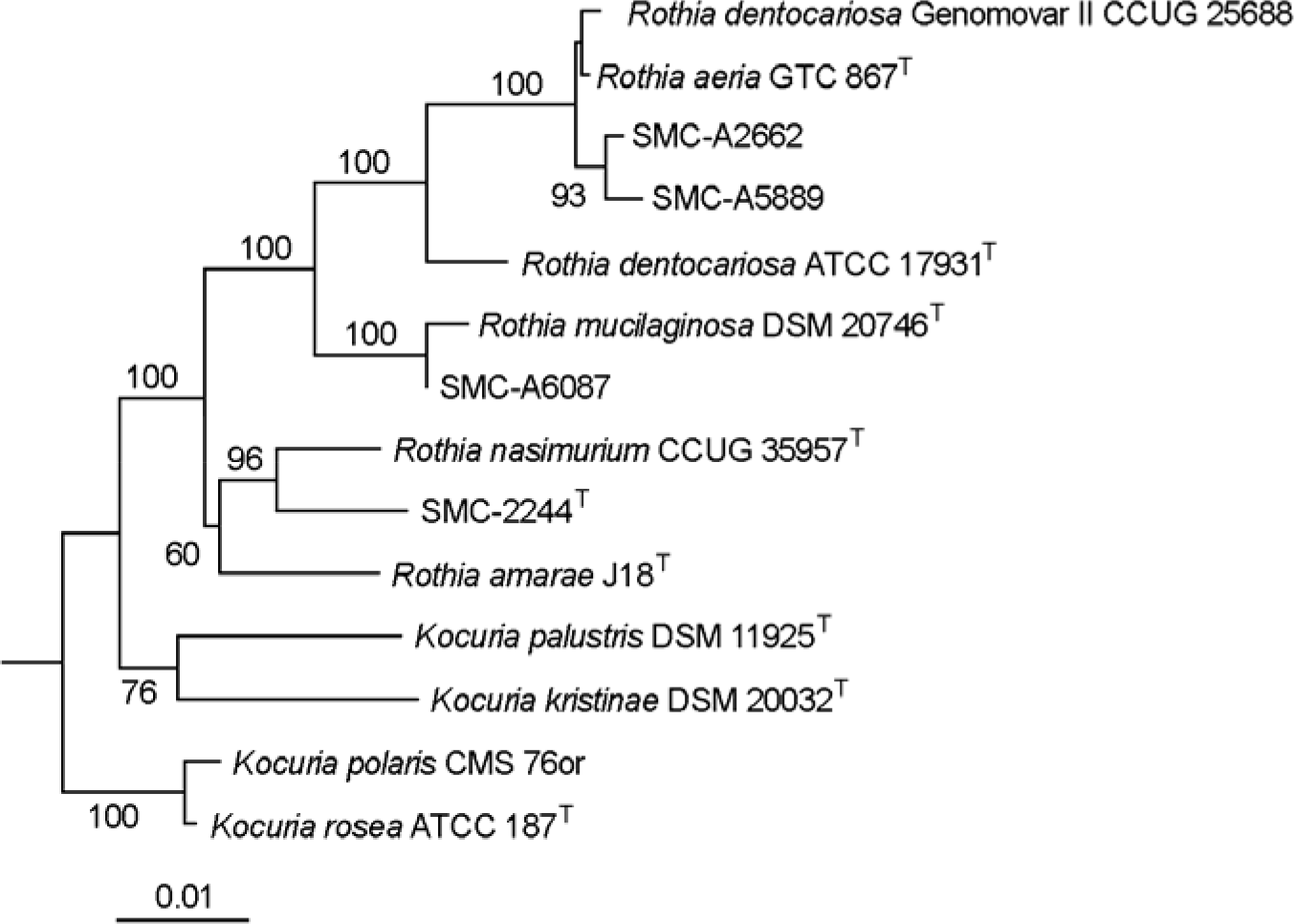Abstract
Four Gram-positive cocci were isolated from the cerebrospinal fluid or blood of four different patients, but they could not be identified by an automated conventional identification system, so they were identified using cellular fatty acid (CFA) composition analysis and 16S rRNA gene sequencing analysis. Of these, two strains (SMC-A2662 and SMC-A5889), which were previously supposed to be Rothia dentocariosa according to the API Coryne system, were identified as Rothia aeria by the 16S rRNA gene analysis. SMC-A608, which was unidentified by both the VITEK2 and API Coryne systems, was identified as Rothia mucilaginosa. The one remaining SMC-2244T was distinguished from the other Rothia species by its biochemical profile, its CFA composition and its 16S rRNA gene sequence. Phylogenetic analysis showed that it was closely related to Rothia nasimurium but the 16S rRNA gene sequence dissimilarity of 1.8% was enough to differentiate it from R. nasimurium. Based on both the phenotypic and phylogenetic evidence, we propose a new species name for this bacterium, Rothia arfidiae sp. nov. The results of this study show that several Rothia species were isolated from human and we have identified them using 16S rRNA gene sequences.
Go to : 
REFERENCES
1). Georg LK., Brown JM. Rothia, gen. nov., an aerobic genus of the family Actinomycetaceae. Int J Syst Bacteriol. 1967. 17:79–88.
2). Fotos PG., Gerenscer MA., Yelton DB. Strain differenation of Rothia dentocariosa and related isolates by sodium dodecyl sulfate-polyacrylamide gel electrophoresis. Int J Syst Bacteriol. 1984. 34:102–6.
3). Collins MD., Hutson RA., Båverud V., Falsen E. Characterization of a Rothia-like organism from a mouse: description of Rothia nasimurium sp. nov. and reclassification of Stomatococcus mucilaginosus as Rothia mucilaginosa comb. nov. Int J Syst Evol Microbiol. 2000. 50:1247–51.
4). Fan Y., Jin Z., Tong J., Li W., Pasciak M., Gamian A., Liu Z., Huang Y. Rothia amarae sp. nov., from sludge of a foul water sewer. Int J Syst Evol Microbiol. 2002. 52:2257–60.
5). Li Y., Kawamura Y., Fujiwara N., Naka T., Liu H., Huang X., Kobayashi K., Ezaki T. Rothia aeria sp. nov., Rhodococcus baikonurensis sp. nov. and Arthrobacter russicus sp. nov., isolated from air in the Russian space laboratory Mir. Int J Syst Evol Microbiol. 2004. 54:827–35.
6). Boudewijns M., Magerman K., Verhaegen J., Debrock G., Peetermans WE., Donkersloot P., Mewis A., Peeters V., Rummens JL., Cartuyvels R. Rothia dentocariosa, endocarditis and mycotic aneurysms: case report and review of the literature. Clin Microbiol Infect. 2003. 9:222–9.
7). Daneshvar MI., Hollis DG., Weyant RS., Jordan JG., MacGregor JP., Morey RE., Whitney AM., Brenner DJ., Steigerwalt AG., Helsel LO., Raney PM., Patel JB., Levett PN., Brown JM. Identification of some charcoal-black-pigmented CDC fermentative coryneform group 4 isolates as Rothia dentocariosa and some as Corynebacterium aurimucosum: proposal of Rothia dentocariosa emend. Georg and Brown 1967, Corynebacterium aurimucosm emend. Yassin et al. 2002, and Corynebacterium nigricans Shukla et al. 2003 pro synon. Corynebacterium auricmucosm. J Clin Microbiol. 2004. 42:4189–98.
8). Kronvall G., Lannér-Sjőberg M., von Stedingk LV., Hanson HS., Pettersson B., Falsen E. Whole cell protein and partial 16S rRNA gene sequence analysis suggest the existence of a second Rothia species. Clin Microbiol Infect. 1998. 4:255–63.
9). Shin JH., Shim JD., Kim HR., Sinn JB., Kook JK., Lee JN. Rothia dentocariosa septicemia without endocarditis in a neonatal infant with meconium aspiration syndrome. J Clin Microbiol. 2004. 42:4891–2.
10). Ko KS., Peck KR., Oh WS., Lee NY., Lee JH., Song JH. New species of Bordetella, Bordetella ansorpii sp. nov., isolated from the purulent exudate of an epidermal cyst. J Clin Microbiol. 2005. 43:2516–9.
11). Zhu XY., Zhong T., Pandya Y., Joerger RD. 16S rRNA-based analysis of microbiota from the cecum of broiler chickens. Appl Environ Microbiol. 2002. 68:124–37.

12). Shukla SK., Vevea DN., Frank DN., Pace NR., Reed KD. Isolation and characterization of a black-pigmented Corynebacterium sp. from a woman with spontaneous abortion. J Clin Microbiol. 2001. 39:1109–13.
13). von Graevenitz A. Rothia dentocariosa: taxonomy and differential diagnosis. Clin Microbiol Infect. 2004. 10:399–402.
14). Paściak M., Holst O., Lindner B., Mierzchała M., Grzegorzewicz A., Mordarska H., Gamian A. Structural and serological characterization of the major glycolipid from Rothia mucilaginosa. Biochim Biophys Acta. 2004. 1675:54–61.
Go to : 
 | Figure 1.Phylogenetic relationships of four Rothia isolates based on 16S rRNA gene sequences. This tree was constructed using the Neighbor-joining method and bootstrap values were evaluated from 1,000 replications. The scale bar indicates the estimated number of substitutions per 100 nucleotides. Micrococcus lylae d10 was used as an outlier. |
Table 1.
Rothia isolates identified in this study
| Isolates | Patient (sex/age) | Isolation | Specimen | Underlying disease | Species |
|---|---|---|---|---|---|
| SMC-A5889 | F / 52 | Oct, 2004 | Blood | Pituitary adenoma | Rothia aeria |
| SMC-A2662 | M / 59 | Dec, 2004 | Blood | Chronic renal failure | Rothia aeria |
| SMC-A6087 | F / 2 | Jun, 2004 | Blood | Pneumonia | Rothia mucilaginosa |
| SMC-2244T | F / 22 | Feb, 2004 | CSFa | Pituitary adenoma | Rothia arfidiae sp. nov b |
Table 2.
Biochemical profiles of Rothia isolates a
| Isolates | Nitrate reduction | Pyrrolidonyl arylamidase | Alkaline phosphatase | α-glucosidase | Catalase |
|---|---|---|---|---|---|
| SMC-A5889 | + | + | – | + | + |
| SMC-A2662 | + | + | – | + | + |
| SMC-A6087 | – | + | – | – | – |
| SMC-2244T | + | – | + | + | + |
Table 3.
Fatty acid compositions of four isolates of Rothia species a




 PDF
PDF ePub
ePub Citation
Citation Print
Print


 XML Download
XML Download